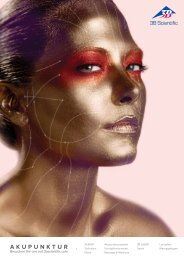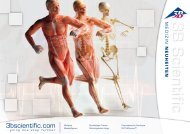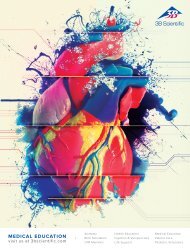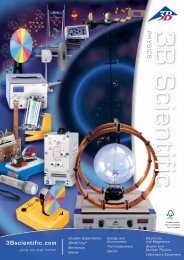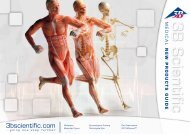3B Scientific - Biology Catalog
3Bscientific.com
3Bscientific.com
You also want an ePaper? Increase the reach of your titles
YUMPU automatically turns print PDFs into web optimized ePapers that Google loves.
Information About Microscopes<br />
Wide field eyepieces<br />
Siedentopf head<br />
Tube<br />
Revolving quadruple<br />
nosepiece with objectives<br />
Stand<br />
Object guide<br />
Object stage<br />
Coaxial adjustment for<br />
coarse and fine focussing<br />
Abbé condenser<br />
Illumination<br />
x-y Cross-table<br />
adjustment<br />
Mains switch<br />
Base<br />
Course Microscope<br />
Course microscopes are robust, low-cost microscopes with basic optical<br />
features that are ideally suited for lessons in school or for beginners in<br />
microscopy.<br />
Barrel<br />
The barrel is the tube in which the oculars can be placed.<br />
Monocular barrel: for observation with a single eye.<br />
Binocular barrel: for stereo observation. This makes the work easier<br />
and less tiring than with a monocular microscope.<br />
Trinocular barrel: for stereo observation but also allowing for addition<br />
of a camera.<br />
Ocular<br />
The ocular magnifies the real image thrown by the microscope’s objective.<br />
The diameter of the field of vision, i.e. the area of the slide that<br />
can be viewed at one time, is calculated by dividing the field number by<br />
the scaling factor. Thus for a 10x 18 mm ocular, the viewing field has a<br />
diameter of 1.8 mm.<br />
Objective Revolver<br />
The objective revolver accommodates between 3 and 5 objectives and<br />
makes it possible to change the magnification rapidly when viewing a<br />
slide.<br />
Objective<br />
An objective produces a real image of the object. The size of the image<br />
is given by the scaling factor (e.g. 10x) and the resolution is determined<br />
by the numerical aperture (e.g. 0.65). The larger the numerical aperture<br />
the more detailed the image produced.<br />
Achromatic objectives provide only a limited amount of correction for<br />
lens aberrations but this is nevertheless sufficient for most uses that<br />
arise in schools. Planar achromatic objectives eliminate image field curvature<br />
and throw an image that is uniformly focussed from the centre<br />
of the field of vision to the edge.<br />
Resolution of Objectives<br />
The resolution of an objective is given by the following formula<br />
l<br />
d = 2 · A<br />
where d = distance between two points, l = wavelength of the light,<br />
A = numerical aperture<br />
Example: numerical aperture = 0.65, l = 0.55 µm, resolution<br />
d = 0.423 μm.<br />
Object Stage<br />
The object stage is the shelf upon which slides are placed for observation<br />
through a microscope. Using an x-y cross-table allows the slide to<br />
be moved by specific distances along the x and/or y axes. The scales<br />
mean that once a specific location on the slide has been found, it is<br />
easy to locate it again.<br />
Condenser<br />
The function of a condenser is to allow for careful adjustment of the<br />
aperture to ensure an optimum compromise between image contrast<br />
and resolution. As the aperture is made smaller, the contrast increases<br />
but the resolution is simultaneously reduced.<br />
Coarse and Fine Focussing<br />
Coarse and fine adjustment gears allow for optimum focussing of an<br />
image. They are mostly fitted along a common axis on either side of the<br />
column leading up from the base.<br />
Illumination<br />
Microscope slides can be illuminated by means of incandescent tungsten<br />
lamps, fluorescent tubes, LEDs or halogen lamps. Halogen lamps<br />
are best suited to the task because they provide such intense light. Fluorescent<br />
tubes and LEDs eliminate the problem of slides warming up due<br />
to the heat from the light during longer periods of observation.<br />
Microscopy<br />
...going one step further 63





